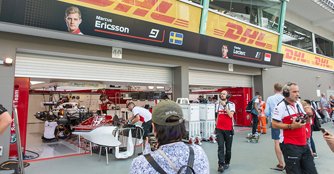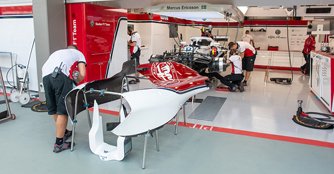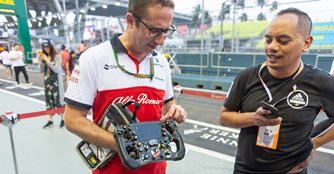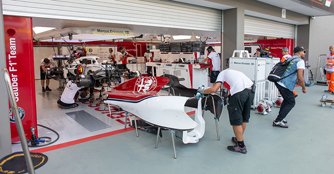A day with the Alfa Romeo Sauber F1 Team
18 Sep 2018|3,846 views
In December 2017, Alfa Romeo signed a multi-year technical and commercial partnership agreement with the Swiss Sauber F1 Team for participation in the Formula One world championship, beginning this year, with the 2018 season.

This partnership, officially named the Alfa Romeo Sauber F1 Team, also provides additional opportunities for the two organisations in both Formula One and the automotive sector in general.
For fans, Alfa Romeo's comeback restores one of the greatest names that have gone down in the history of motorsport's premium championship, Formula One.
The C37 weapon
The Italian brand's single-seaters, named C37, sport the distinctive colours and logo of Alfa Romeo, as well as the team's Title Sponsor, and are equipped with Ferrari powertrains.

The C37 was built based on a new car philosophy, focusing on the aerodynamic concept that is different to that of the outgoing Sauber C36-Ferrari. The C37 is also equipped with new and improved aerodynamic parts, in addition to regulation changes for 2018, such as the removal of the shark fin and T-wings.
More importantly, the C37 marks the return of 'Quadrifoglio', the legendary badge that has appeared on Alfa Romeo's top performance cars since 1923, to the circuits. Featured on the engine cover of the C37, the famous good-luck charm has a fascinating history, deeply rooted in the racing world. The first Alfa Romeo car to carry the Quadrifoglio was the 'RL' driven by Ugo Sivocci, which won the 15th edition of the Targa Florio in 1923.
The C37 are driven by Swedish racing driver Marcus Ericsson and Monegasque Charles Leclerc. This however, will be Leclerc's last season with the Alfa Romeo Sauber F1 Team, as the 21-year old has agreed on a contract with Scuderia Ferrari for the 2019 season where he will drive alongside Sebastian Vettel, taking the place of 2007 Formula One World Champion Kimi Raikkonen who will swop over to the Alfa Romeo Sauber F1 Team next year.
Where the magic happens
At the recently concluded Singapore Grand Prix at the Marina Bay Street Circuit, we met up with Mauro Tonini, Partnership Manager for Sauber, who let us into the Alfa Romeo Sauber F1 Team garage for a rare up close and personal peep into what goes on behind the scenes.
While we were asked us not to take any photos or videos from inside the garage, as there are a lot of top-secret competitive stuff on display, we did get the full run-down of how it all works together.
There, the race team comprises mechanics who look after the cars, engineers who are responsible for analysing data obtained over a race weekend, advisers from the engine supplier, race engineers who talk to the drivers throughout the race and advise on strategy, team principals and senior management, as well as a whole raft of supporting departments dealing with logistics, public relations, catering and hospitality, information technology and communications.

Then, the team transforms it into a clinically tidy workspace for the weekend, with storage space for items you would never think would have their own little cubbyholes.
Parts and spares are labelled to a tee and stowed away efficiently and at the back, behind two huge carbon fibre floors for the cars, is an endless wall of tyres that are wrapped up in heating blankets, powered by control boxes, which allow the tyre technicians to accurately set the ideal temperatures necessary.
There is an estimated 50 team members in and around the garage at any point of time, and according to Mauro, the Alfa Romeo Sauber F1 Team has in employment over 400 globally.
In December 2017, Alfa Romeo signed a multi-year technical and commercial partnership agreement with the Swiss Sauber F1 Team for participation in the Formula One world championship, beginning this year, with the 2018 season.

This partnership, officially named the Alfa Romeo Sauber F1 Team, also provides additional opportunities for the two organisations in both Formula One and the automotive sector in general.
For fans, Alfa Romeo's comeback restores one of the greatest names that have gone down in the history of motorsport's premium championship, Formula One.
The C37 weapon
The Italian brand's single-seaters, named C37, sport the distinctive colours and logo of Alfa Romeo, as well as the team's Title Sponsor, and are equipped with Ferrari powertrains.

The C37 was built based on a new car philosophy, focusing on the aerodynamic concept that is different to that of the outgoing Sauber C36-Ferrari. The C37 is also equipped with new and improved aerodynamic parts, in addition to regulation changes for 2018, such as the removal of the shark fin and T-wings.
More importantly, the C37 marks the return of 'Quadrifoglio', the legendary badge that has appeared on Alfa Romeo's top performance cars since 1923, to the circuits. Featured on the engine cover of the C37, the famous good-luck charm has a fascinating history, deeply rooted in the racing world. The first Alfa Romeo car to carry the Quadrifoglio was the 'RL' driven by Ugo Sivocci, which won the 15th edition of the Targa Florio in 1923.
The C37 are driven by Swedish racing driver Marcus Ericsson and Monegasque Charles Leclerc. This however, will be Leclerc's last season with the Alfa Romeo Sauber F1 Team, as the 21-year old has agreed on a contract with Scuderia Ferrari for the 2019 season where he will drive alongside Sebastian Vettel, taking the place of 2007 Formula One World Champion Kimi Raikkonen who will swop over to the Alfa Romeo Sauber F1 Team next year.
Where the magic happens
At the recently concluded Singapore Grand Prix at the Marina Bay Street Circuit, we met up with Mauro Tonini, Partnership Manager for Sauber, who let us into the Alfa Romeo Sauber F1 Team garage for a rare up close and personal peep into what goes on behind the scenes.
While we were asked us not to take any photos or videos from inside the garage, as there are a lot of top-secret competitive stuff on display, we did get the full run-down of how it all works together.
There, the race team comprises mechanics who look after the cars, engineers who are responsible for analysing data obtained over a race weekend, advisers from the engine supplier, race engineers who talk to the drivers throughout the race and advise on strategy, team principals and senior management, as well as a whole raft of supporting departments dealing with logistics, public relations, catering and hospitality, information technology and communications.

Then, the team transforms it into a clinically tidy workspace for the weekend, with storage space for items you would never think would have their own little cubbyholes.
Parts and spares are labelled to a tee and stowed away efficiently and at the back, behind two huge carbon fibre floors for the cars, is an endless wall of tyres that are wrapped up in heating blankets, powered by control boxes, which allow the tyre technicians to accurately set the ideal temperatures necessary.
There is an estimated 50 team members in and around the garage at any point of time, and according to Mauro, the Alfa Romeo Sauber F1 Team has in employment over 400 globally.
Thank You For Your Subscription.

































